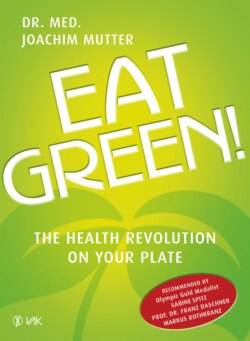Eat Green!

Реклама. ООО «ЛитРес», ИНН: 7719571260.
Оглавление
Joachim Dr. med. Mutter. Eat Green!
Dr. Joachim Mutter. Eat Green! The Health Revolution. on Your Plate. Preface by Prof. Dr. Franz Daschner. Foreword by Markus Rothkranz. Postface by Sabine Spitz
Contents
Foreword by Markus Rothkranz
Preface by Prof. Dr. Franz Daschner, MD
Introduction
Part I. Why nutrition causes. diseases
The body of man is composed of what he eats
Are organic foods healthier?
Does “organic” always mean healthy?
And what about animal products?
A healthy diet and a slim body – an utopia?
Research results: what is a healthy diet?
Why have wild animals survived for centuries?
What wild animals are doing differently to humans
Trials and errors in the history of nutritional sciences
Is the calorie content important?
Ill by fat?
The debate on protein. Important studies and historical experience
The difference between raw and heated protein
Current views on the protein problem
Accelerating Aging and Cancer through animal protein
The best protein nourishment for humans
There are many adverse effects from animal protein
Milk is not good for children and adults
How much protein do humans need?
Why carbohydrates?
Friends in your bowel
Why too much protein is sickening
Do no-carb diets make you ill?
Animal Proteins lead to supertoxins in your bowel
The gut makes you ill
Good bacteria for longest-living
How butyric acid detoxes the intestines, gives energy and makes you slim
Dietary fibers for health
The secret of healthy herbivores: Muscle
Easy fat-burning for endless energy
Muscle without protein in food?
The protein and vitamin solution: Your gut
Proteins from air?
Survival world-wide
More protein in stool than in food
Healthy and muscular despite lack of protein
What these humans have in common with peas
The intestinal flora and its health
“Good” intestinal bacteria – effective against depression
“Good” intestinal bacteria strengthen our immune system
What can harm our “good” intestinal bacteria
Things that support our “good” intestinal bacteria
Without animal foods: what are the effects?
Sensational cures
Surprising side effects
Ideal weight despite overeating
Why an animal free diet makes you slim
Are we carnivores (predators) or herbivores (vegans)?
What did prehistoric men eat?
Why people eat meat
Studies show: vegetarians are healthier
Are vegetarians outsiders?
Consequences of animal consumption on earth
Do humans need carbohydrates?
Faster aging due to carbohydrates
Insulin – the No. 1-“disease hormone”
Which foods do contain too many carbohydrates?
A few more remarks to this overview
Should the Glycemic Index (GI) be a guideline?
Fructose – health risk and “fat trigger”
Why fructose is harmful
Fructose causes illnesses
The fructose-”trick” that doesn’t work
How much fructose per day?
Artificial Sweeteners – not a healthy solution
Aspartame (E 951)
Neotame
Sucralose (e.g. Splenda)
Raw or heated foods?
The stove – a “chemical plant”
What happens when food is heated
Diabetics: What can they eat?
Opium in food
Cigarettes on the spoon
Caramel in the brain
Cooked foods make tired
Heated food makes you age faster
Uncooked vegetable food keeps young and heals
Successful treatments with raw food – early research results
Part II. Eat green!
Recommendations for the changeover of your diet
What you should eat as much as possible
How much you should eat
When you should eat
What you should drink
Exceptions for drinking juices
Organic products are better than conventional foods
Does “organic” always mean organic?
More fresh than heated food!
Be careful if you have diseases or take drugs!
Cooked meals – for healthy people
What you should generally avoid
A minimum recommendation or compromise formula for healthy persons
Those who are severely ill as well as those who want to have more energy – eat green without exception!
Further recommendations for a healthy diet
Possible intolerances, or, “if there is something you can’t digest” …
Unfavorable combinations
Raw and cooked at the same time
Fruit, honey, dried fruit
Raw vegetables mixed with industrial foods
Grains, seeds, nuts, cereal
Improper food preparation
Hypoglycemia – hyperglycemia: Stop it
Chlorophyll – the most important nutrient
14 wild plants – my special recommendations
1. Dandelion (Taraxum officinale)
2. Narrowleaf or buckhorn plantain (Plantago lanceolata L.)
3. Stinging nettle (Urtica dioica L.)
4. Linden leaves and blossoms (Tilia platyphyllos Scop. = largeleaf linden, Tilia cordata Mill. = littleleaf linden)
5. Bishop’s weed (also called goutweed, Aegopodium podagraria L.)
6. Chickweed (Stellaria media agg.)
7. Hedge bedstraw and false cleavers (Galium mollugo agg. and Galium aparine agg.)
8. Daisies (Bellis perennis L.)
9. White goosefoot (Chenodopium album)
10. Common beech (Fagus sylvatica)
11. Norway spruce, European silver fir (European pine = Pica abies, Swiss pine = Abies alba)
12. Common Hogweed (Heracleum sphondylium L.)
13. Red clover (Trifolium pratense L.)
14. Maple leaves and blossoms (Acer)
Grass and grass powders
Algae
Healthy meals
Breakfast. Flaxseed muesli
An alternative breakfast
Lunch and dinner
At any time of day: Green smoothies and raw vegetable juice!
Ingredients and preparation of the main meals
Herbs, vegetables, salads
Sprouts
Fats and oils
Salt and spices
Why salt? – It’s minerals you need!
When you have a craving for sweets
Fruit, dried fruit and berries
Healthy sweets
Suggested recipes for sweets and desserts. Berry ice cream
Chocolate
Wild raw vegetable cake
Raw vegetable crackers and chips
Ranking of the most health foods
Eating green in winter?
Closing remarks
Postface by Sabine Spitz
Glossary
References
Books (recommended)
Dr. Joachim Mutter
Отрывок из книги
Foreword by Markus Rothkranz
Preface by Prof. Dr. Franz Daschner, MD
.....
Possible intolerances, or, “if there is something you can’t digest”
Chlorophyll – the most important nutrient
.....